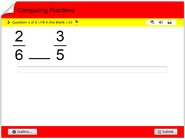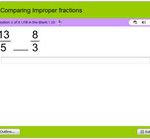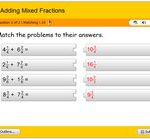Comparing fractions quiz
Test your skills with this online exercise Comparing fractions quiz.
Comparison of two fractions quiz online, greater, less than or equal to
Comparison of two fractions quiz online, greater, less than or equal to. This quiz will also serve as a math game for children. This activity is in line with the curriculum for 3rd, 4th, 5th and 6th grades, hence will serve as a review exercise for children at this level. It is also a free math activity which teachers and parents could use to supplement their math course. After taking this quiz, print out math worksheets on the same topic and get more practice offline.
When we compare fractions, we are looking at two or more fractions and determining which one is larger or smaller. To compare fractions, we need to make sure that the fractions have the same denominator, or bottom number. This is because the denominator tells us how many parts the whole is divided into, and if the denominators are different, it can be difficult to compare the fractions because they are not talking about the same number of parts.
For example, if you wanted to compare the fractions 1/4 and 1/3, you would need to first find a common denominator. A common denominator is a number that both fractions can be converted to, so that they have the same denominator. In this case, a common denominator would be 12 because 4 and 12 have no common factors other than 1 and 3 and 12 is the least common multiple. Now that we have a common denominator, we can convert 1/4 to 3/12 and 1/3 to 4/12. Now we can compare these fractions.
3/12 < 4/12
We can tell that 1/3 is greater than 1/4 because 4 is larger than 3.
Another way to compare fractions is by looking at the numerator, or top number. The numerator tells us how many parts of the whole we have. In general, the larger the numerator, the larger the fraction.
For example, if you wanted to compare the fractions 2/5 and 3/5, you would look at the numerators.
2/5 < 3/5
We can tell that 3/5 is greater than 2/5 because 3 is greater than 2.
We can also convert the fractions to decimal numbers, by dividing the numerator by the denominator, that way is much easier to compare them.
Another example, let’s say we have to compare the fractions 5/8 and 7/12, we can convert them to decimals, 5/8 = .625 and 7/12 = .583, this way we can tell that 5/8 is greater than 7/12
It’s important to notice that when we are comparing fractions with different denominators it’s necessary to have a common denominator, or convert them into decimal numbers, to have a fair comparison.
Another way of comparing fractions is by simplifying them. When a fraction is simplified, it means that the numerator and denominator have no common factors other than 1. Simplifying a fraction makes it easier to compare because it shows the fraction in its simplest form.
For example, let’s compare the fractions 6/12 and 8/16, in order to compare them, we can simplify them first, 6/12 can be simplified to 3/6, which is the same as 1/2, and 8/16 can be simplified to 1/2
1/2 = 1/2
We can tell that both fractions are equal, 6/12 and 8/16 are the same.
In summary, when comparing fractions, it’s necessary to make sure that the fractions have the same denominator, or convert them into decimal numbers, to have a fair comparison. Another way of comparing them is by looking at the numerator, the larger the numerator, the larger the fraction. Also, it’s a good idea to simplify the fractions whenever possible.



